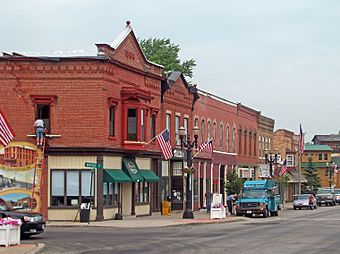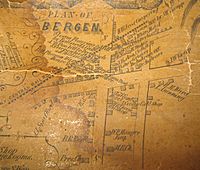Lake Street Historic District (Bergen, New York) facts for kids
Quick facts for kids |
|
|
Lake Street Historic District
|
|

Buildings on North Lake Street, 2010
|
|
| Location | Bergen, NY |
|---|---|
| Nearest city | Batavia |
| Area | 2.3 acres (9,300 m2) |
| Built | 1880–1921 |
| Architectural style | Romanesque Revival |
| NRHP reference No. | 85001953 |
| Added to NRHP | September 5, 1985 |
The Lake Street Historic District is a special area in downtown Bergen, New York. It's located on the west side of Lake Street, which is also NY 19. This district is famous for its beautiful buildings built between the late 1800s and early 1900s.
Many of these buildings are designed in the Romanesque Revival style. This style uses strong, rounded arches and decorative details. Most of these buildings were built after the village had two big fires. After the fires, wooden buildings were banned, so new ones were made of brick. One of these historic buildings is even used as Bergen's town hall today!
Many buildings here still have their original cast iron storefronts. Because of their history and unique style, the Lake Street Historic District was added to the National Register of Historic Places in 1985.
Exploring the Buildings of Lake Street
The Lake Street Historic District includes 11 important buildings. They are all found along the west side of Lake Street. Two buildings (10 and 12 South Lake Street) are south of Buffalo Street. The other nine (11–27 North Lake) are to the north. The CSX railroad tracks mark the northern edge of the district.
All these buildings take up most of their land. Together, they cover about 2.3 acres (0.93 hectares). Each building helps make the district special and historically important.
Almost all the buildings are two stories tall with flat roofs. Only one building, 23 North Lake Street, has just one story. Many buildings have cool decorations. These include cornices (decorative tops) with corbels (support brackets) and dentils (small block shapes). Another common feature is the cast iron storefronts. Most of these still look just like they did when they were first built. The upper floors of these buildings are often used as offices or homes.
Here are the 11 buildings in the district:
- 10 South Lake Street: This two-story brick building has a flat roof and a cast iron storefront. It was built in 1888. Its original decorative top (cornice) was changed in 1930.
- Masonic Temple, 12 South Lake Street: The Masons built this after their first building burned down in a 1906 fire. It's a two-story brick building with a flat roof. It has large windows with rounded tops.
- Tulley Block, 11 North Lake Street: This building is similar in size and material to 10 South Lake. It was built in 1886. Its front has a fancy top with "1886" written on it. The side facing Buffalo Street has "Tulley Block" and a mural showing local history. This building is now the village hall.
- 13 North Lake Street: This was one of the first new buildings after the 1880 fire. It has a decorative top with the building's date. Its cast iron storefront still has its original metal trim and decorations.
- 15 North Lake Street: Built a year after its neighbor, this building looks very similar. Its top was changed in 1906, and brick was added around 1950.
- 17 North Lake Street: This building is similar to its southern neighbor but has four sections on its front.
- 19 North Lake Street: This building is similar in size and material to 17 North Lake. Its storefront is still original, and its window tops are made of stone arches.
- Sackett-Merrill-White American Legion Home, 21 North Lake Street: This two-story building was built in 1881. It has a detailed decorative top and arched windows with wedge-shaped stones.
- 23 North Lake Street: This is the newest building in the district, built in 1921. It's the only one-story building and was a small grocery store. It has decorative brickwork and its original cast iron storefront.
- 25 North Lake Street: Built in 1913, this building has decorative brickwork and a detailed decorative top. Its second-story window was changed in 1971, and the storefront has also been updated.
- Housel Bank, 27 North Lake Street: This building, from 1906, has a decorative top and unique corner stones called quoins. Its second-story windows have flat brick arches. The storefront was changed in 1971.
A Look at Bergen's Past
Bergen was first settled in 1801. It started as a small town that helped the farms around it. The town grew faster after 1836 when the Buffalo and Rochester Railroad was built nearby. When the New York Central Railroad took over in 1853, Bergen continued to develop. Around the time of the American Civil War, downtown Bergen had four blocks of wooden commercial buildings.
In 1866, a big fire destroyed buildings on three blocks of Lake Street. But the town's economy was strong, so they rebuilt. Bergen officially became a village in 1877.
Three years later, in 1880, another fire hit the same area. This time, 45 buildings were destroyed, including 31 businesses. After this fire, the village decided that new buildings could not be made of wood. This is why the replacement buildings were made of brick.
Within two years of the fire, buildings from 13 to 27 North Lake were built. They featured cast iron storefronts and Romanesque Revival details, which were popular at the time. The Tulley Block, at the corner of Buffalo Street, was built in 1886.
Bergen was very successful in the years that followed. New businesses like a cigar factory, a creamery, and gas and coal works opened. Another fire in 1906 destroyed older buildings at the north end of the street. These were replaced more slowly. Only 25 North Lake was built right away. Seven years later, in 1913, 27 North Lake was added. These two buildings show designs, like patterned brickwork, that were common in the early 1900s. The Masonic Temple, which also burned down in the 1906 fire, built its new home at 12 South Lake Street.
The last empty space from the 1906 fire was filled in 1921 with 23 Lake Street. This building, a grocery store, is the only one-story building in the district today. After this, no more major buildings were added. Bergen and its businesses faced challenges during the Great Depression. The Housel Bank at 27 North Lake even closed. Later, railroads became less important as new highways like Interstate 490 and the New York State Thruway were built. In the late 1960s and early 1970s, efforts were made to improve downtown Bergen. The east side of Lake Street was largely torn down to make way for newer buildings.
Today, Bergen has recovered somewhat. It's now a place where people live and commute to larger cities like Rochester and Batavia. The village uses the Tulley Block as its offices, and some storefronts are home to businesses again. While a few buildings have been changed over time, the Lake Street Historic District still looks much like it did in the past.




